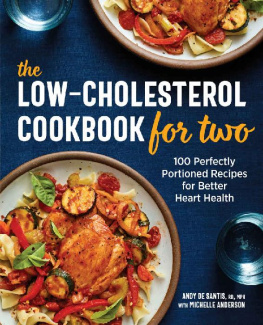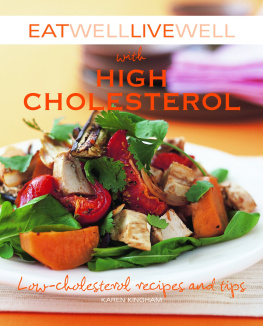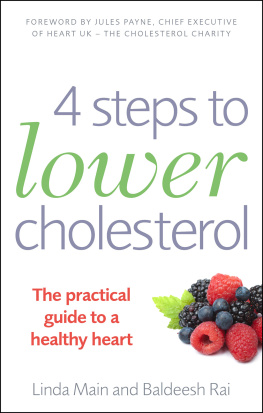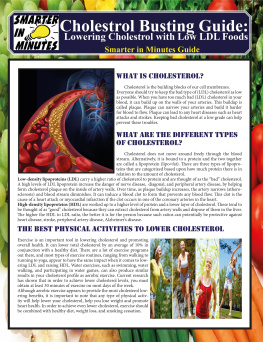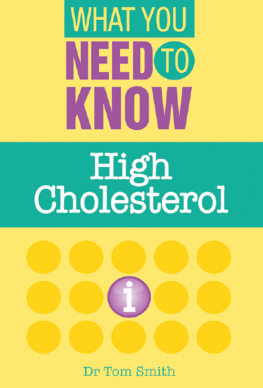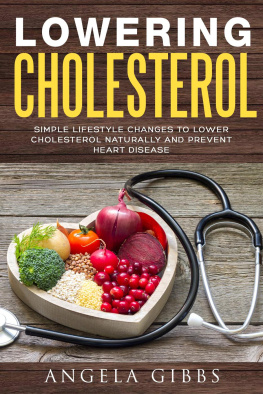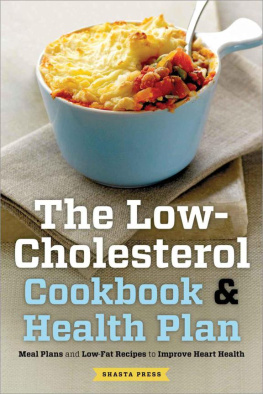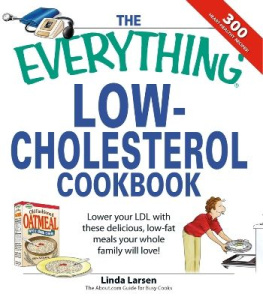Cholesterol has a terrible reputation. However, despite the fact that increasing numbers of people are being advised that their cholesterol levels are too high and that they should try to reduce them, theres a lot of confusion about what this means and how it should be achieved.
It has been estimated that as many as 70 per cent of people over the age of 45 in the Western world have levels of blood cholesterol that are too high to be considered healthy levels that put them at risk. A significant number of younger people are thought to be developing high levels, or to already have them. High levels of cholesterol in the blood are important because they substantially increase the risk of developing cardiovascular disease (CVD), a term which includes coronary heart disease (CHD) and stroke. A high cholesterol level alone is likely to be responsible for 46 per cent of all premature deaths from coronary heart disease in Britain.
Doctors often hand out basic diet sheets when patients have high blood cholesterol levels and may provide some initial information and, in some cases, drugs though this is often relatively rudimentary. There are some widely publicised products available, from spreads and breakfast cereals to prescription drugs, which can be used to lower cholesterol levels with varying degrees of effectiveness. As a result it is recognised that having a high cholesterol level is potentially dangerous, but exactly what this means and how it affects us is less well understood.
Most of us have heard of good and bad cholesterol, though just what that means is even less frequently discussed. It is easy to be left with the impression that you just have to eat the right foods, containing the right kind of cholesterol, while avoiding others (eggs are often quoted). Ideas like these are widespread but they are completely incorrect: you cant eatgood cholesterol and you dont have to avoid eggs.
There is so much information out there that the soundness of the basic advice that doctors give can be drowned out by extraneous noise. Making basic changes to your diet and lifestyle can help reduce your cholesterol levels, and those changes are not complicated.
Another fact that is often obscured is that cholesterol is actually necessary; we all need it in order for our bodies to function. The risk associated with it comes into play when levels are too high, and the aim of managing your cholesterol levels is to reduce that risk, thus lowering your chance of developing cardiovascular disease and having a heart attack or stroke.
WHAT IS CHOLESTEROL?
Fat is transported around the blood as lipids a collective term for all fatty substances in the blood. Lipids include phospholipids, trigylcerides (which you will probably first encounter in a blood cholesterol test), waxes and sterols. Cholesterol is a sterol, doubtless the best known. Its a waxy substance in the blood, mostly manufactured and/or processed in the liver, and none of us can live without it. In small amounts it is essential for our health, and it is found in every single cell of the body.
Cholesterol builds and maintains the membranes of cells as well as the insulating sheaths that run around nerve fibres, sending messages to and from the brain and around the body. It occurs in very high concentrations in these cells, which protect the nervous system and brain, and is therefore especially important when those systems are developing. Its one of the base ingredients of hormones such as oestrogen and testosterone; of cortisol, which helps us adapt to stress; of aldosterone, which ensures that the body regulates salt and potassium levels;and of Vitamin D, without which the body cannot absorb and use the calcium needed to build and maintain healthy bones.
Cholesterol is used in the liver to make bile acids, which are then stored in the gall bladder. They enable the body to dissolve fats from food and thus help the digestive process to work more effectively. This action also ensures that the vital fat-soluble vitamins (A, D, E and K) can be absorbed as well. So, while having too much cholesterol can be very bad, life without it would be impossible.
Moving cholesterol around the body
In order for cholesterol to get to where it is needed, it has to be moved from the liver and transported around the body in the bloodstream. Rather like oil and water, fats and blood plasma dont mix, and cholesterol doesnt dissolve in blood either. To make it possible for fats to move in the circulatory system, they are packaged into particles covered with proteins. The proteins do more than just protect the fat, though; they seem to act rather like email addresses, sending the particles in the right direction. These particles, known as lipoproteins, are able to flow along with the blood, mixing easily with it. The lipoproteins contain some cholesterol, which helps to stabilise them, and by this means cholesterol is carried around the body too. Lipoproteins can be compared to car transporters, couriers or delivery trucks, dropping off some items and picking up others.
Lipoproteins vary and are classified generally according to the balance of fat and protein they contain. Those with more protein and less fat are denser and heavier than those which have more fat than protein, which have been described as light and fluffy. As far as cholesterol goes, the most important lipoproteins are high-density lipoprotein (HDL), the more fat-laden low-density lipoprotein (LDL) and the very low-density lipoprotein (VLDL). The first two HDL and LDL have become known, somewhat inaccurately, asgood cholesterolandbad cholesterolrespectively. Those shorthand terms have arisen because of how these lipoproteins behave and the effects they can have.
Cholesterol and dietary fats are moved from the digestive tract to the liver by another lipoprotein, chylomicron, which is made in the small intestine. But most of the bodys cholesterol is manufactured in the liver, and this is also where it is packaged for transport together with triglycerides. Briefly, the liver collects fatty acid fragments from the blood and makes new fatty acids and cholesterol from them. It also seems to monitor the amount of dietary cholesterol taken in; if your diet includes a lot, your liver may make less, and vice versa.
Triglyceride-transporting VLDL particles are made in the liver. They carry excess fatty acids from the liver to the adipose tissue the bodys fat stores passing through capillary walls into the surrounding tissue where the free fatty acids are released for storage. After these free fatty acids are released, LDL particles are formed from what remains.
LDL orbad cholesterol
Low-density lipoproteins are the main carriers of cholesterol. They contain a higher proportion than other lipoproteins and move about 70 per cent of the cholesterol in circulation to the body tissue where it is needed. They vary in size and number, and have a protein on the surface which matches a receptor site on the surface of a cell, like a key matching a specific lock. This allows the LDL to pass into the cell where it dissolves and releases the cholesterol it contains.
Most of the cholesterol needed by our cells for instance, to make cell membranes or manufacture sterol compounds such as hormones is supplied in this way. In the genetic disorder called familial hypercholesterolaemia (see page 15), LDL particles are restricted from entering the cells.
If LDL levels are high, however, not all of them are removed from the blood in this way, and some of them end up in the wrong places. They can pass through artery walls, where they are collected by scavenger cells known as macrophages (which also take up other excess particles, like micro-organisms). This is the start of the process that leads to the development ofatherosclerotic plaques fatty deposits that narrow the arteries and can eventually block them, leading to heart attacks and angina.


